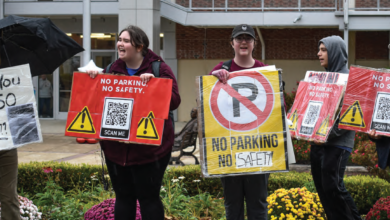
NJ student teachers to receive $3,000 stipend from state
By Jay Roberson
Student teaching is a capstone that all education majors anticipate throughout their college career. Once an unpaid requirement, New Jersey is now offering its full-time student teachers a $3,000 stipend.
Senior secondary education major Vanessa Rivera is currently placed in Camden, New Jersey, and receives $3,000 from the Camden Teacher Pipeline and the state of New Jersey, amounting to $6,000 for the semester.
“When I chose the Camden Teacher Pipeline, the state stipend was not a thing. So I was going because I knew I needed the money. I knew it was in two disbursements, so I could save enough money to get me through halfway then get that other money to carry me to the end,” said Rivera.
In November 2023 New Jersey announced that it will provide $3,000 stipends to students in approved Educator Preparation Programs for the 2024 year as long as they are residents of and teaching in the state.
Tiffany Corcoran, a senior secondary education major, is a Pennsylvania resident and a student teacher there, but is still paying to go to school at Rider during her last semester without a stipend.
“I do think [a stipend] would help for people like me who do want to put all of their time and energy into student teaching that aren’t receiving income for the semester and still have to pay for university,” Corcoran said.

Though not all students qualify for the stipend, Rider still offers other kinds of support to all student teachers, according to partnerships and field placements coordinator Erica Spence-Umstead.
“There’s a number of people who work in support of the student teachers. One would be their academic advisor. I’m another [person]. Student teachers don’t realize that I am a person they can reach out to if they’re having an issue, but I’m always happy to hear from a student,” said Spence-Umstead.
Student teachers are also given the chance to debrief their work days when meeting with their student teaching advisor along with 12-15 other student teachers once a week.
“It’s basically a session where we can get things off our chest, anything we want to complain about,” Rivera said.
Depending on the placement, student teachers are working anywhere from 5-8 hours in and out of the classroom.
Senior elementary education major Lindsay Sherman said, “I get there around 7:45 [a.m.] every morning and leave at the end of the school day at 3 p.m. During the last hour of the school day my kids are in a special, so me and my teacher take that last hour to prep[are], so I really don’t have to do that much outside of school at all.”
Student teachers have to learn how to manage their work and life outside of school so they are not overwhelmed by the plethora of responsibilities.
“We have to learn to properly manage time during the day as much as we can so we don’t have to take so much home as teachers, cause Lord knows that’s why the burnout rate and the shortage is as bad as it is.”
Since student teachers spend a majority of their time in school and planning outside of school, many don’t have the time or energy to take on a part-time job.
“I personally don’t have the time for a job just because during the week I get home at 5 p.m. So by the time I get home, I need dinner, to step in the shower and to go to bed,” said Rivera.
Student teachers ease into their internship with observations for the first few weeks, but over time they take over the entire classroom.
“Your final weeks are kind of where it’s expected that you’re supposed to be the full time teacher in the classroom, but it’s all depending on whatever you and your co-op[erating teacher] think is best for the classroom setting you’re in,” Sherman said.
Rivera has taken over instruction in her classroom and has taught daily instruction for the past month.
“Realistically, especially because our whole time is taken up by student teaching, we don’t even have time to have a little part time job. Even then you’re exhausted and your brain is fried by the end of the day because you’re getting teacher stamina. The compensation is a motivating factor,” said Rivera.
Corcoran said some of her responsibilities in school include keeping up with the Canvas classroom pages, taking roll calls and tracking their grades alongside other grading duties. Outside of the classroom, she’s responsible for making lesson plans and keeping the cooperating teacher updated.
New Jersey student teachers received their $3,000 stipend at the end of March, but Rivera said, “We’re already more than halfway through student teaching. This money is supposed to be helping us with our needs, but I needed stuff last month. They wouldn’t make us go that long without pay.”
Another big cost that student teachers struggle with is gas money. Corcoran said, “There should be a [reduced] tuition for students who are student teaching, since we’re not utilizing many resources at the university, or a stipend that could help cover some of the tuition or help cover other costs, like travel during student teaching.”
Student teachers can travel up to 30 miles away from Rider for their placement, but the field placement office tries their best to accommodate students’ requests.
Spence-Umstead said, “I try to make the closest possible placement where the students want to be knowing that some of them are going to have to drive a little bit, and especially if they’re choosing to live at home.”
Though there are some mental, financial and physical struggles that student teachers face, a majority of them feel that the experience is essential to being a teacher.
Sherman said, “I would easily do this with no stipend obviously because I have to, but because I think the experience is so good. I love teaching; it’s not about the money for me at all. I just see it as a sweet little bonus I get to have.”


